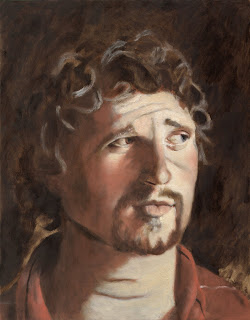The final phase for the painting would be the adjustment phase, which basically is the fine tuning of the painting after completing the color phase. Most of the heavy lifting should have been done in the underpainting phase.
Ironically, the final adjustments actually took longer than the color phase, probably because as the artist you may never really feel that the painting is ever complete. But there is the point where you end up over painting, which is also the point where you want to stop.
First focus here is to emphasis the cooler planes so that the planes that are supposed to recede back into the background are doing just that. Then, there should be some further emphasis on the light effect to ensure that the viewer knows where the light hits the face.
Also, some additional work was done to the background to ensure that it is knocked back and remains the background, so that it does not interfere with the main subject of the painting.
Some additional work was done in the eye area, but that may not show up in the scan. Some more tweaks to the hair to make it look more lively, and additional work was applied to the creases within the shirt of the subject.
After some other minor tweaking, the final result is the painting that you see below.
Friday, September 30, 2011
Wednesday, September 21, 2011
Oil Painting - Color phase
Now we will move onto the color phase, where the color will be applied over the top of the underpainting.
The main goal of this phase would be to lay in the color. The final touch ups and wrapping up the painting will occur in the next phase.
The main goal of this phase would be to lay in the color. The final touch ups and wrapping up the painting will occur in the next phase.
To start off, the canvas gets oiled in, so that the original colors get brought back out. This is done because the paint should be dry from the previous underpainting phase. Once that oils seep in, it is time to apply the colors.

For this painting, I put in more reds for the darker portion, applied where the shadows are, with the exception of the hair. For the lights, a flesh tone is used, with a mix of yellow ochre. There is also some whites applied here, to reduce saturation and to create a light tone in the paniting. Going back and forth from darks and the lights, the color slowly is apparent.
Despite the application of colors to move the painting towards complete, there is still a heavy emphasis on making sure that the area where the light hits the face is. This is achieved with the mix of flesh tone that I use.
Finally some color is applied to the eye. A purplish mix is applied to the eyes, as the model here has blue eyes. Obviously this is very subtle, and probably will not show up in the thumbnail below.
Once the color has been applied to the underpainting, we have the below result.

Sunday, September 18, 2011
Monday, September 12, 2011
Oil Painting - Underpainting part 2
Second part of the underpainting process. I basically redid all of the steps as illustrated by the first part. However, redoing a painting was a helpful process, as I know was a bit more comfortable with the feeling of the paint, as well as how the brush and paints would react with the turpenoid. I was able to be a lot thinner in regards to the paint, and in turn got a more solid painting. Considering I would be painting the colors over this underpainting, it would be useful to keep the underpainting fairly thin when possible.
Also paid extra attention to the anatomy this time around. As demonstrated by the picture below, the results could be drastically different as a result.
Also paid extra attention to the anatomy this time around. As demonstrated by the picture below, the results could be drastically different as a result.
Subscribe to:
Comments (Atom)



